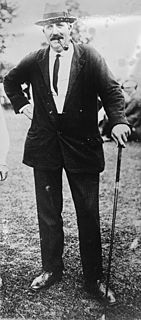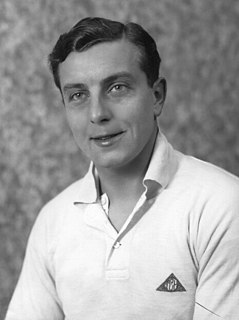The Irish Open is a professional golf tournament on the European Tour. Since 2015, the Irish Open has been hosted by Rory McIlroy, and his charitable foundation is the main benefactor; the title sponsor is Dubai Duty Free.

Edward Rivers John "Ted" Ray was a British professional golfer, one of the leading players of the first quarter of the 20th century. He won two major championships, the Open Championship in 1912 and the U.S. Open in 1920, and contended in many others. He was captain of the British team in the inaugural Ryder Cup, in 1927.
The German Open was a men's golf tournament. It was first staged in 1911 when the winner was Harry Vardon. The following year the champion was another of the Great Triumvirate of late 19th and early 20th century British golfers, John Henry Taylor. The tournament was then not played again for over a decade. It was played each year from 1926 to 1939; Percy Alliss won five times in this era, Auguste Boyer four times and Henry Cotton three.
The British PGA Matchplay Championship was a match play golf tournament that began in 1903 and ran until 1979. Between 1903 and 1969, the event was sponsored by the now defunct British newspaper the News of the World, and was commonly known by the paper's name. Initially organised as the championship of British professionals, the event came to include invited players from other countries – in particular from around the Commonwealth. On occasion, American professionals also took part, notably in 1949 when eight members of the victorious U.S. Ryder Cup side accepted invites to the event, Lloyd Mangrum reaching the semi-finals.

The 1923 Open Championship was the 58th Open Championship, held 14–15 June at Troon Golf Club in Troon, South Ayrshire, Scotland. Arthur Havers holed a bunker shot on the 72nd hole to win his only major title, one stroke ahead of defending champion Walter Hagen, who won the following year.

The 1931 Open Championship was the 66th Open Championship, held 3–5 June at Carnoustie Golf Links in Carnoustie, Angus, Scotland. Tommy Armour outlasted José Jurado by a single stroke to win his only Open title, and his third and final major championship. This was the first time Carnoustie hosted the championship.

The 1937 Open Championship was the 72nd Open Championship, held 7–9 July at Carnoustie Golf Links in Carnoustie, Scotland. Henry Cotton won the second of his three Open titles, two strokes ahead of runner-up Reg Whitcombe. The Ryder Cup was held in late June at Southport and Ainsdale Golf Club in North West England, and all the members of the victorious American team played in the championship, creating a star-studded field, similar to four years earlier in 1933.

The 1938 Open Championship was the 73rd Open Championship, held 6–8 July at Royal St George's Golf Club in Sandwich, England. In terrible weather conditions that caused scores to soar, Reg Whitcombe prevailed by two strokes over runner-up Jimmy Adams to win his only major title. The purse was £500 with a winner's share of £100.
The Dunlop-Metropolitan Tournament was an invitation professional golf tournament played in South East England. It was founded in 1934. The tournament was played towards the end of the season and was played over 72 holes of stroke play. The event had a small field; entry being mostly based on high finishes in important British and Continental events earlier in the year. Past Open Champions were also invited. The tournament was informally called "The Championship of Champions" and was "equivalent almost to the Masters' tournament of America" which was also founded in 1934.
The Daily Mail Tournament was a professional golf tournament played in the United Kingdom. The Daily Mail sponsored the St Andrews Tournament in 1919 and in 1920 continued their sponsorship with the start of the Daily Mail Tournament. The event was dropped after the 1927 tournament and not reinstated until 1936. The event was unusual in that it took place in 1940, after the start of World War II. The prize money for the 1940 event was just £500, money being raised for the Red Cross A tournament was also played in September 1945, soon after the end of the war, and was informally referred to as the "Victory" tournament. The last event was played in 1950.

The Silver King Tournament was a professional golf tournament played at Moor Park Golf Club near Rickmansworth, Hertfordshire. The event was promoted by The Silvertown Company, manufacturer of the Silver King golf ball. It was held from 1936 to 1953.

The True Temper Foursomes Tournament was a professional golf tournament played in West Bromwich, England. The event was held just once, in 1939, and had total prize money of £1,000. The tournament was a 36-hole foursomes event played on 3 and 4 May. It was won by Dick Burton and Fred Robson in a three-pair 18-hole playoff on 5 May. "True Temper" was a brand of steel golf shafts.

The Penfold Professional Golf League was a professional golf tournament played in England. The event was held twice, in 1938 and 1939. It was contested by 12 players, each playing the other in a round robin format. Everyone played two matches per day for the first five days and another match on the final day, a Saturday. Two points were awarded for a win and one point for a halved match. Total prize money was £1,000 with £200 for the winner. The tournament was sponsored by Penfold Golf.
The Leeds Cup is a golf tournament that has been played annually in northern England since 1902. The event is organised by the north region of the Professional Golfers' Association. It is the oldest trophy in professional golf that is still played for. The Tooting Bec Cup is older, having been first played for in 1901, but is no longer contested.
The PGA Assistants' Championship is a golf tournament for golf club assistant professionals. It is held by the British PGA.

The County Down Professional Tournament was a golf tournament played in Newcastle, County Down, Ireland. The event was held just once, in 1898, and had total prize money of £105.
Ernest Edward Whitcombe was an English professional golfer. He was the son of Ernest Whitcombe and was always known as Eddie.

The 1913 News of the World Match Play was the eleventh News of the World Match Play tournament. It was played from Tuesday 7 to Thursday 9 October at Walton Heath Golf Club. 32 players competed in a straight knock-out competition, with each match contested over 18 holes, except for the final which was over 36 holes. The winner received £100 out of a total prize fund of £400. George Duncan defeated James Braid 3 & 2 in the final to win the tournament. This was Braid's fifth final but the first time he had been beaten.






